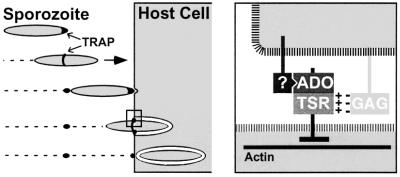Fig. 6. Hypothetical model for the role of the two TRAP adhesive modules during Plasmodium sporozoite invasion of host cells. Plasmodium sporozoites reach their target cells through gliding locomotion. Left part, TRAP is capped backwards during gliding motility and host cell invasion. The A-domain MIDAS and the TSR of TRAP are not required for this step. Initial host cell attachment is TRAP independent, but induces a burst of TRAP secretion at the sporozoite tip. Right, host cell invasion requires the formation of a junction between the sporozoite anterior end and the host cell. The A-domain, which binds to an as yet unidentified host cell receptor (?) in a MIDAS-dependent fashion, and the TSR, which recruits glycosaminoglycan chains (GAG) via a charged interaction, presumably act during this step of junction formation. An actin-based motor system then generates force, which is transmitted via the TRAP cytoplasmic tail and exerted on the host–parasite junction. This allows the sporozoite to locomote inside the so-called parasitophorous vacuole.

An official website of the United States government
Here's how you know
Official websites use .gov
A
.gov website belongs to an official
government organization in the United States.
Secure .gov websites use HTTPS
A lock (
) or https:// means you've safely
connected to the .gov website. Share sensitive
information only on official, secure websites.
